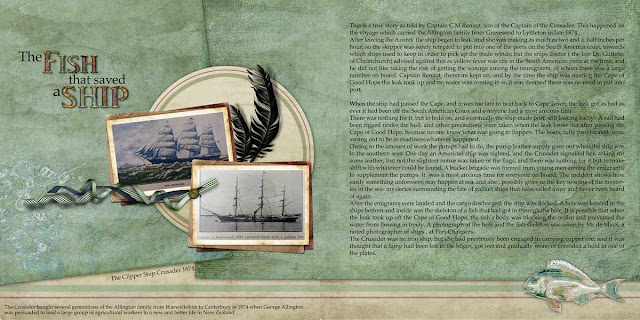The Crusader bought several generations of the Allington family from Warwickshire to Canterbury in 1874 when George Allington was persuaded to lead a large group of agricultural workers to a new and better life in New Zealand.
This is a true story as told by Captain C.M Renaut, son of the Captain of the Crusader. This happened on the voyage which carried the Allington family from Gravesend to Lyttleton in late 1874.
After leaving the Azores the ship began to leak. and she was making as much as two and a half inches per hour, so the skipper was sorely tempted to put into one of the ports on the South America coast, towards which ships used to keep in order to pick up the trade winds; but the ships doctor ( the late Dr. Guthrie, of Christchurch) advised against this as yellow fever was rife in the South American ports at the time, and he did not like taking the risk of getting the scourge among the immigrants, of whom there was a large number on board. Captain Renaut, therefore kept on, and by the time the ship was nearing the Cape of Good Hope the leak took up and no water was coming in so it was deemed there was no need to put into port.
When the ship had passed the Cape, and it was too late to beat back to Cape Town, the leak got as bad as ever it had been off the South American Coast and everyone had a most anxious time.
There was nothing for it, but to hold on, and eventually the ship made port, still leaking badly. A sail had been rigged under the hull, and other precautions were taken when the leak broke out after passing the Cape of Good Hope, because no one knew what was going to happen. The boats, fully provisioned, were swung out to be in readiness whatever happened.
Owing to the amount of work the pumps had to do, the pump leather supply gave out when the ship was in the southern seas. One day an American ship was sighted, and the Crusader signalled her, asking for some leather, but not the slightest notice was taken of the flags, and there was nothing for it but to make shift with whatever could be found. A bucket brigade was formed from young men among the emigrants, to supplement the pumps. It was a most anxious time for everyone on board. The incident shows how easily something unforeseen may happen at sea, and also , possibly gives us the key to some of the mysteries of the sea- mysteries surrounding the fate of gallant ships that have sailed away and never been heard of again.
After the emigrants were landed and the cargo discharged, the ship was docked. A hole was located in the ships bottom and inside was the skeleton of a fish that had got in through the hole. It is possible that when the leak took up off the Cape of Good Hope, the fish’s body was blocking the orifice and prevented the water from flowing in freely. A photograph of the hole and the fish skeleton was taken by Mr de Maus, a noted photographer of ships , at Port Chalmers.
The Crusader was an iron ship, but she had previously been engaged in carrying copper ore, and it was thought that a lump had been left in the bilges, got wet and gradually wore, or corroded a hold in one of the plates.
Story taken from :The clipper ship Crusader, built 1865, broken up 1910 : memories and records of over fifty years' pioneering. With special reference to voyages 1874-1879 / Published 1928.


No comments:
Post a Comment